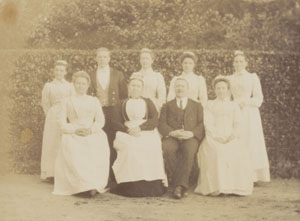
|
Domestic ServiceMost households, except the poorest, would have had at least one servant to carry out the heavier domestic chores. Slightly better-off households might run to a maid and a cook, and perhaps a nursery maid and a handyman or coachman/driver, who would probably live on the premises. Farms would also employ female workers to assist with tasks, such as dairy production. The numbers of servants increased in proportion to the size of the house and the wealth or status of the family. The large landed estates might have a hundred staff, including stable and outdoor workers, while their domestic staff might also include laundry and dairy maids. The personal staff from “above-stairs” such as maids or footmen would follow the family members if they went to another house, particularly during the Winter Season in London, while the remaining domestic staff would be reduced to a minimum. A good housekeeper was essential to the running of the kitchens and the female domestic staff in a larger establishment, while a butler was required for the management of the male serving staff and the wine cellar. In 1819 the agent to the Duke of Sutherland was enquiring about finding a housekeeper for a cousin in Scotland: “She must be able to undertake the management of the kitchen when he has company and be a good Cook, but know how to pickle, preserve etc, be able to instruct the servants in baking and brewing and to keep monthly accounts, to take charge of the House & Linen. He would be willing to pay from 30-35 guineas with coals, vegetables and milk. He would prefer a woman who has served the most of her time in the country and she must always have been in a good gentleman’s family,... her age not under 30 nor above 45.” A memorandum of 1830 about footmen's duties in the family of the Marquess of Stafford states that one had to be "dressed by 9 o'clock to attend to the Bells and Blinds of the lower apartments only and under no pretence to quit the Hall unless sent and then to return immediately" The second was to be "dressed by half past 11 o'clock and to attend to the blinds of the upper apartments regularly... this footman to take charge of the dinner of the day and have the dirty things cleared in the morning, by getting up, which must be insisted upon and which can easily be done, as they go to bed early. The dinner hour to be 12 o'clock. The 3rd footman to go messages or go out with the carriage when required." References were usually essential, but good servants could take their pick of positions or might move regularly between employers by choice. The greatest fear for any servant would be to come to the end of his or her working life without the security of a continuing position, or an annuity or savings. |
